


THE NAPOLEONIC WARS 1803 -
THE BATTLES OF JENA AND
AUERSTADT -
xxxxxAs we have seen, after his
victories over the Austrians and Russians at the Battles of Ulm and
Austerlitz in 1805,
Napoleon set up
the Confederation of the Rhine, a union of German states firmly
under French protection. Alarmed at this development, and having
made a secret alliance with Russia, in October 1806, King Frederick
William III of Prussia declared war on France and, without waiting
for the support of his ally, sent two armies into Saxony. Napoleon,
splitting his own army into two, met the two forces at Jena and Auerstadt in mid-
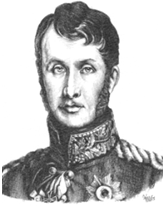 xxxxxAs we have seen, following his decisive victories over
the Austrians and Russians at the Battles of Ulm and Austerlitz in 1805, Napoleon consolidated his position in central Europe
by forming the Confederation of the Rhine, a loose union of German
states firmly under French protection. This extension of French
power right up to the Prussian border was more than King Frederick
William III (Illustrated)
was prepared to accept. Making a secret pact with Russia in July
1806, he abandoned Prussia’s neutral policy -
xxxxxAs we have seen, following his decisive victories over
the Austrians and Russians at the Battles of Ulm and Austerlitz in 1805, Napoleon consolidated his position in central Europe
by forming the Confederation of the Rhine, a loose union of German
states firmly under French protection. This extension of French
power right up to the Prussian border was more than King Frederick
William III (Illustrated)
was prepared to accept. Making a secret pact with Russia in July
1806, he abandoned Prussia’s neutral policy -
xxxxxFacing his new enemy -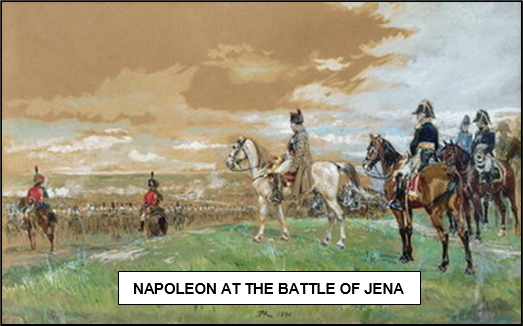
xxxxxNapoleon’s plan was to
crush the enemy force at Jena and then swing his army 13 miles north
to join up with his smaller force at Auerstadt, ready to take on the Duke of Brunswick. There proved
to be no need for such a manoeuvre. The two Prussian armies, neither
well-
xxxxxAs we shall see, Napoleon
then went on to defeat the Russians and Prussians at the Battles of
Elau and Friedland in 1807,
and this forced both Russia and Prussia to sue for peace. At the
humiliating Treaty of Tilsit that year, the Prussians were made to
pay an extremely high price for their foolhardy policy. Had they
joined the Third Coalition earlier, combining their forces with
those of Austria and Russia in 1805, for example, it might well have
stopped Napoleon in his tracks or, at least, limited the extent of
his advance. As it was, they chose to ally themselves with the
Russians in 1806 -
 xxxxxIncidentally, Frederick
William III of Prussia was the man who instituted the military
decoration known as the Iron Cross. It was first awarded for distinguished service in the
Prussian War of Liberation (against the French in 1813-
xxxxxIncidentally, Frederick
William III of Prussia was the man who instituted the military
decoration known as the Iron Cross. It was first awarded for distinguished service in the
Prussian War of Liberation (against the French in 1813-
Acknowledgements
William III:
detail, 1906, artist unknown, contained in Volume III of The
Life of Napoleon Bonaparte by the American historian
William Milligan Sloane (1850-
Including:
Congreve Rockets

G3c-
xxxxxCongreve rockets were first used successfully by the British during an
attack on the French naval base at Boulogne in October 1806, the
month when the Battles of Jena and Auerstadt were fought. They were
designed by an artillery officer, William Congreve, and were based
on a crude but effective weapon which had been used against the
British in 1792 and 1799 (G3b) during the Anglo-
xxxxxIt was in October 1806, at the time of the Battles of Jena and Auerstadt, that the British first used Congreve rockets to good effect. They were employed in an attack on the French port of Boulogne and, light to handle and easy to launch, they proved highly successful in destroying many of the invasion barges moored in the harbour.
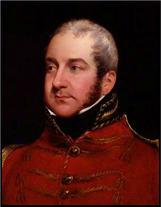 xxxxxAs we have seen, the British learnt about rockets to
their cost when they were used against them by Tippu Sahib during
the third and fourth Anglo-
xxxxxAs we have seen, the British learnt about rockets to
their cost when they were used against them by Tippu Sahib during
the third and fourth Anglo-

xxxxxLater refinements
followed. By trimming the length of its fuse the warhead could be
timed to explode at a required distance, and two types of charge
were introduced -
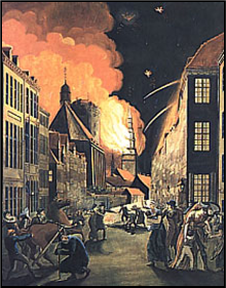 xxxxxFollowing their success at Boulogne, Congreve rockets
proved highly successful the following year (1807) when, launched in
their thousands, they virtually destroyed the centre of the city of
Copenhagen (illustrated),
and the French fleet that was sheltering in its harbour. Similar
rockets were later used in the Battle of Waterloo, and, as we shall
see, they were employed on numerous
occasions during the War of 1812 against the United States. Such were their success that
within a few years almost every country in Europe had made similar
rockets, and formed specialised brigades as part of their artillery
units. Whilst they were not very accurate, such rockets were a
useful terror weapon and, compared with conventional guns, were
lighter in weight, simpler to “fire”, and far easier to transport.
xxxxxFollowing their success at Boulogne, Congreve rockets
proved highly successful the following year (1807) when, launched in
their thousands, they virtually destroyed the centre of the city of
Copenhagen (illustrated),
and the French fleet that was sheltering in its harbour. Similar
rockets were later used in the Battle of Waterloo, and, as we shall
see, they were employed on numerous
occasions during the War of 1812 against the United States. Such were their success that
within a few years almost every country in Europe had made similar
rockets, and formed specialised brigades as part of their artillery
units. Whilst they were not very accurate, such rockets were a
useful terror weapon and, compared with conventional guns, were
lighter in weight, simpler to “fire”, and far easier to transport.
xxxxxLater,xin
1844, an English engineer named William
Hale (1797-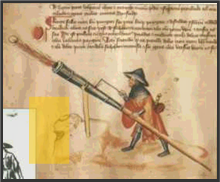 used
in both the Mexican War and in the American Civil War.
used
in both the Mexican War and in the American Civil War.
xxxxxIncidentally, as noted when covering the Fourth Anglo-
xxxxx…… Upon the death of his father in 1814, Congreve inherited his father’s baronetcy and was appointed comptroller of the Royal Laboratory at Woolwich Arsenal. He was the Member of Parliament for Plymouth, in Devon, from 1818 until his death in 1828.


